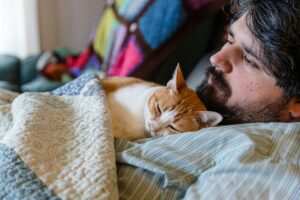
Head tension - nobody wants it; nearly everyone gets it! Not all head tension is the same, though, and recognising what type you have can be the difference between remedy and prolonged suffering. Read on for how to distinguish between the types and for tips to help you deal with them, naturally.
群组
A type that can persist for several minutes to several hours each episode. They return regularly for weeks or months and affect around 1% of the population. They are six times more common in males than in females and usually occur in those who have a higher consumption of alcohol or who smoke. They usually come on rapidly, without warning, and peak within 2-15 minutes, with the discomfort felt around the eye or temple, and are always unilateral (affects only one side of the head). They usually last for thirty minutes to two hours (average 45 minutes) in about 75%. Cluster head tension is often described as feeling like a “hot poker” being driven through the eye. Other symptoms that can occur are eye redness, tearing, and nasal drainage. The discomfort usually begins in, around, or above the eye or the temple and occasionally the face, neck, or ear may be affected.
劳累
这些症状通常是由于剧烈运动引起的,包括后脑勺周围的严重不适。运动性头部紧张影响到 10% 的人,男性多于女性。好消息是,它们通常会在几分钟内消退。它们可能是脱水、血压升高或血液循环不畅造成的。
严重
严重的头部紧张以反复跳动为特征,开始时往往伴有强光闪烁、视力模糊或麻木等症状。
典型 "严重程度与 "普通 "严重程度的区别在于 "先兆"。"先兆 "在典型发作前约 30 分钟发出信号。这种 "先兆 "表现为呼啸的闪光和/或黑点或盲点,使正常视野扭曲,发作可持续 1 到 72 小时。
常见的特征是头部一侧,尤其是前额或太阳穴部位的搏动性剧痛,有时伴有恶心、呕吐以及对光线或噪音的敏感性。
这些症状是由于脑血管先收缩后扩张造成的,影响 10% 的人口,其中女性 17%,男性 5%;最易受影响的人群是 25 至 44 岁的女性。此外,该病还有很强的遗传倾向。
反弹
反跳性头部紧张通常是由于过度使用镇痛药造成的。典型的症状包括:药效消失后 3-4 小时,不适感再次出现;每天(或几乎每天)都会出现,持续时间从 6 小时到一整天,或每隔一天,甚至每隔三天。打破反弹周期的最佳治疗方法显然是与医生或药剂师合作,停止服用或减少镇痛药的剂量。这样做一开始可能会加剧不适感,但一旦停用镇痛药,不适感就会得到改善。
简单
These begin as dull discomfort or a “squeezing” in the back of the head that spreads to the crown of the head and the forehead. They are characterized by a feeling of pressure. Tension discomfort accounts for 80% of all head tension.
其他
有些是因为感染、过度活跃的免疫反应或季节性疾病和寒冷。

原因多种多样,但也有一些常见原因...
- 显而易见的原因,如过量饮酒和摄入咖啡因--你知道吗,摄入超过 240 毫克咖啡因的人头部紧张的发生率比不摄入咖啡因的人高出 25%,而且他们还可能出现咖啡因戒断症状。这通常发生在最后一次摄入咖啡因后的 18 小时左右。
- 过量摄入某些氨基酸也可能导致头部紧张,包括天门冬氨酸、谷氨酸、谷氨酸钠(味精)、苯丙氨酸和酪胺酸。
- 念珠菌过度生长和肠道高渗透性(尤其是在进食后发生)也可能是另一个原因,因此照顾和修复消化系统健康非常重要。向自然疗法师寻求帮助。
- 对麸质食品的反应也可能导致头部紧张,尤其是患有乳糜泻的人,因为麸质食品会引起脑部炎症。
- 砷、铜、铅和汞是重金属,可能是中毒的原因,也可能是中毒的症状。
- 过多的血清素循环可能会收缩血管。
- 吸烟可能是诱发因素,红酒也可能是诱发因素,尤其是对那些组胺不耐受的人来说,因为红酒中组胺含量很高。
- 食品添加剂--阿斯巴甜可能会导致头部紧张,这主要是由于阿斯巴甜中含有甲醇。
- 压力过大也是常见原因。
- 对于女性来说,头部紧张也可能是雌激素过多或月经前的症状。
- 过量摄入某些维生素会导致头部紧张,其中包括- 胆碱(群聚型)、维生素 A、超过 100 毫克的烟酸(维生素 B3 的一种形式)以及过量的维生素 D。
- 缺乏某些维生素,包括生物素、维生素 B1 缺乏症(每天补充 1,000-4,000 毫克维生素 B1 可缓解多达 78% 病人的头部紧张)、维生素 B5、维生素 D 和胆碱(群集)。
- 缺铁可能会导致头部紧张,一旦缺铁得到治疗,这种情况就会缓解。
经过科学研究,为头部紧张提供支持:
轻度至中度
- 维生素 B3
- 5-HTP
- 钙 和 镁 support cardiovascular musculature.
- 退热草
- Fish Oils (approximately 4,500 mg per day containing 800 mg of EPA and 500 mg of DHA).
- 在前额和太阳穴局部涂抹薄荷油。
- Levagen®+,一种更易吸收的棕榈酰乙醇酰胺(PEA)形式
严重
- 肉碱,肉类中的一种氨基酸。
- 长期使用后补充 S-Adenosylmethionine (SAMe)。
- 色氨酸
- 5-HTP
- 来自月见草油的γ-亚麻酸(GLA)。
- 来自动物脂肪的奥米加 3 脂肪酸。
- Combining 钙 和 Vitamin D3.
- 每天补充 600 毫克镁。
- 150mg of Coenzyme Q10.
- 甲基磺酰基甲烷(MSM)。
一般维生素
- 维生素 B2 每天最多 400 毫克
- 维生素 B3(500 - 1,000 毫克)。
- Vitamin B6 deficiency and Vitamin B12.
- 维生素 E 可缓解经期头部紧张。
食物、草药和一般生活方式因素
- 退热草每天 50 - 80 毫克。
- 生姜
- 银杏叶
- 其他有帮助的方法包括针灸、运动、光疗和经颅磁刺激。
触发器:
- 压力导致的皮质醇水平升高与此有关,因为它们通常发生在压力期间或之后。
- 幽门螺旋杆菌
- 铜或钠含量过高。
- 食物过敏。
- 咖啡、酒精、可可(巧克力)、精制糖、高度加工的奶酪和其他乳制品(或对乳制品过敏者的任何乳制品),以及阿斯巴甜、味精(MSG)、亚硝酸钠和三氯蔗糖等食品添加剂。
A great way to determine which type you’re suffering from is to keep a diary of what you’re eating, when you’re exercising and your daily environment, noting down any associations with frequency. After diarising this information for a month or so, you can look back at what is regularly occurring on the days you are suffering from head tension.
TAPSPP1825
